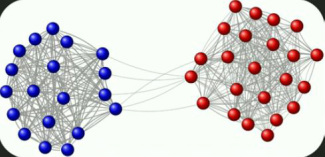 The complex social network of a bat colony The complex social network of a bat colony Tags: biology, science/technology, animals, society, 11 to 20 mins Year: 2013 Length: 13:45 Access: TED Talks Summary: In this TED talk, Nicolas Perony shows how animal groups have many interacting parts that follow simple individual rules to make up complex societies. He works through examples of dogs humorously moving synchronously, the social network dynamics of bat colonies, and how subordinate and dominant meerkats interact to successfully navigate risky physical space (see also this NYT video on "elephant empathy"). His talk first illustrates an important feature of society: the whole is greater than the sum of its parts. By working together, individual animals maintain stable social structures that meet the needs of the community and can help a species’ adaptability to their environment. The animals are highly dependent on one another for survival, and often adopt distinct behaviors that enable them to contribute to the whole. The second point is cautionary and comes at the very end of the video. When Perony concludes his presentation, the host joins him on stage and asks him: “Is it okay to do these associations [between animals and humans]? Are there stereotypes … that can be valid across all species?” Perony deftly responds that “there are also counter-examples to these stereotypes. For example, in the seahorses and koalas, these are males that take care of the young—always. The lesson is that it’s often difficult and sometimes dangerous to draw parallels between humans and animals.” Viewers might be urged to consider why such parallels are dangerous. For example, these arguments are often evoked to justify inequalities (e.g. that males dominate women within society, or with the pseudo-science of eugenics), although such parallels have also been used to legitimate equality and social solidarity in human societies (see Wilkinson and Pickett’s The Spirit Level, especially chapter 14). Submitted By: Paul Dean
3 Comments
Mandy
5/23/2023 01:52:56 am
Finally!!! I am the happiest woman to be called a mother soon. I am saying this because I am very grateful to Dr. Odunga for helping me with my relationship problems faced in my marriage due to the issues of infertility after 7 years of marriage. My husband and I have tried so many options for a successful fertility including IVF but it was futile. My husband's family have said different abusive words to me and my husband and he almost stopped loving me after many years of marriage without a child from me. It was a long time of sorrow for me and it affected me mentally. Dr. Odunga was introduced to me by a friend whom he helped and that was how I contacted Dr Odunga at [email protected] and within 2 days of contact, he did the spell and I successfully conceived after sleeping with my husband as he said. It was very surprising and overwhelming with joy and still unbelievable because I have been seeing testimonies of spell casters but never believed I would be helped by one. Dr. Odunga is indeed a great spell caster. Get in contact with this man to help you solve your problems at [email protected] or Whats App his phone number at +2348167159012
Reply
Manuel Franco
7/29/2023 02:11:24 am
I just want to say Thank You to everyone who supported me through the years. My name is Manuel Franco, New Berlin, Wisconsin. My story of how I won the Powerball lottery of $768.4M is a bit of a tale. I have been playing Powerball tickets for 6 years now since I turned 18. I bought my first ticket on my 18 birthday. I was feeling very lucky that day because I had contacted Dr. Odunga Michael to help me with the winning Powerball numbers. I really had that great great feeling that I looked at the camera wanting to wink at it. I only did a tiny part of it and trusted him. He gave me the numbers after I played a couple other tickets along with it for $10. I checked my ticket after the winnings came online and saw the numbers were correct including the Power play. I screamed for about 10 minutes because it felt like a dream. I had won $768.4M. You can check my winning testimony with the lottery officials just with my name search. Thank you Dr Odunga. Well, his email is [email protected] and you can also call or Whats-app him at +2348167159012 so you guys can contact him
Reply
mark hold
7/7/2024 03:42:01 pm
Herbal Penis Enlargement product is 100% guaranteed to Enlarge and get a better ERECTION, the reason why most people are finding it difficult to enlarge Penis is that they believe in medical reports, drugs and medical treatment which is not helpful for Penis Enlargement. Natural roots/herbs are the best remedies which can easily Enlarge your Penis permanently Contact Dr MOSES BUBA via Email: [email protected] or via WhatsApp: +2349060529305. for Natural root and herbal remedies put together to help Enlarge manhood and Erect healthily. I also learn that Dr MOSES BUBA also can cure other types of diseases, HEPATITIS B,DIABETICS,CANCER,HPV,LOW SPERM CAM, HIV/STDS, FIBROSIS LOST OF WEIGHT, BREAST ENLARGEMENT, HIPS and BUMS ENLARGEMENT etc .
Reply
Leave a Reply. |
Tags
All
.
Got any videos?
Are you finding useful videos for your classes? Do you have good videos you use in your own classes? Please consider submitting your videos here and helping us build our database!
|
 RSS Feed
RSS Feed
